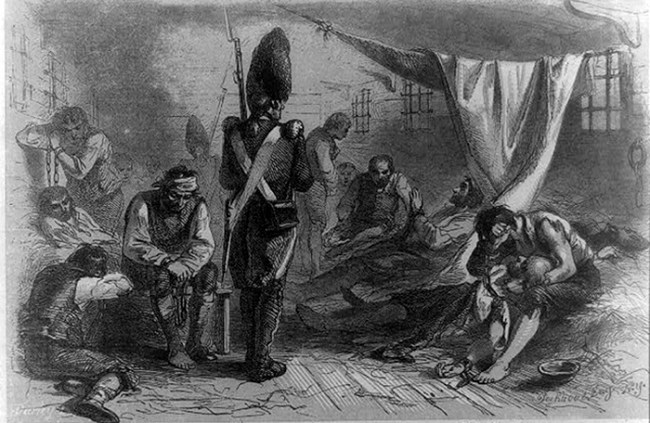
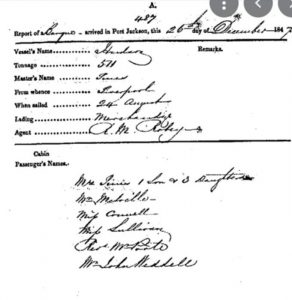
The sailing Barque ‘Hudson’ 26th December 1847, Liverpool to Sydney, with Mrs Pines and children
A large part of the fun of family history is making contact with distant relatives that you never knew you had. This is especially so nowadays with the joys of the internet and this story owes much to an email I received from Pamela Hunt of Australia who contacted me a few years ago calling me “The Pillinger Expert”!
This story begins with Jacob Pillinger, a relatively shadowy figure, who married a St George girl, Ann Muntin or Munton. They moved to Bedminster where their children were born: Mary Ann, 1791, John, 1793, Elizabeth, 1796, Ellen Dent, 1797, Ann, 1800, Sarah, 1802, Charlotte, 1803, and William, 1807. Of these children only Mary Ann, Ellen, Ann, Charlotte and Sarah survived.
Jacob, who had served an apprenticeship with a Bristol shipwright, got into trouble with the law and in 1809 was sentenced to transportation at the Bristol Assizes for the theft of sugar. A brief newspaper account of his conviction and removal to the prison Hulks is retold in a petition for leniency submitted by James Buck, his co-accused, and 25 inhabitants of Portishead.[1] From this document we learn that Jacob Pillinger was a boatswain, Buck, a Custom’s House Officer and Richard Fryer, the other accused, a constable, all upwardly mobile and on the surface, respectable, which must have made it all the more shocking. The theft took place on 20th October, 1808, from the vessel “Nelson”, then in the floating dock at Bristol, belonging to a Mr. Miles. The recommendation of the Tribunal in the case of Buck was “no mercy” and he “sent to (a hulk at) Guildford” in 1810. Fryer obtained a Free Pardon in 1813, having also spent the ensuing years imprisoned in a prison hulk. Jacob aged 42, was sent to the Hulk “Captivity” on 10th April 1809, sentenced to 7 years transportation for “Grand Larceny”. Family legend has it that he “escaped”. Is this what the “E” stands for with the date 22nd May 1811? In any event, Jacob was never heard from again, though the story was known by my Dad, in a garbled account.

Meanwhile, in Bristol, Ann Pillinger, now a single parent, and presumed widow, made the best of it and became the licensee of a pub, the “Talbot” on Redcliffe Hill. I had never followed Ann’s story until Pamela’s email sent me on the trail again.
Ann’s surviving daughters grew up and married: Mary Ann to Francis Clark, Ann to Thomas Francis Sinnett, (described as an accountant at the baptism of their son, Frederick at St Mary Redcliffe in 1816), Ellen Dent to William Pines, Charlotte to William Trowbridge and Sarah to William Farler.
On the 23rd April 1823, Ann was fined £5 for “offences against her licence”, but remained in charge of the pub until 1826 when her daughter, Ann Sinnett, by then, presumably also a widow, took over the licence.
The marriage of a seafaring man, William Pitt Pines to Ellen Pillinger “both of this parish” took place on 25th October 1824 at St George (East) church where three years previously her sister Ann had also been married to T.F. Sinnett. No doubt Muntin family members still lived in the parish. They are the direct ancestors of Pamela Hunt and it is their story which forms the bulk of this article.
William Pitt Pines and his wife Ellen Pines resided at the parish of St Mary Redcliffe where most of their children were baptised as follows:
15th October 1826: Emma daughter of William and Ellen Pines, mariner, St Mary Redcliffe. (She married a master mariner, James Best in Liverpool in 1846. They later settled in Geelong, Victoria where James became a pilot. Emma died in 1900 in Melbourne.)
21st December 1828: William son of William and Ellen Pines, mariner, Langton Street. (He worked as a mariner and is believed to have married twice.)
24th October 1830: John son of William and Ellen Pines, mariner, St Mary Redcliffe. (He also went to sea and gained his mate’s certificate.)
11th July 1831: Ellen daughter of William and Ellen Pines, master mariner, Bedminster. (Ellen married a master mariner, George Silke, in Liverpool in 1852.)
10th November 1833: Charlotte daughter of William and Ellen Pines, master mariner, St Mary Redcliffe. (She married in Melbourne in 1854, a master mariner, John Spence and died in Cape Town, South Africa in 1861.)
3rd December 1834: Matilda daughter of William and Ellen Pines, master mariner, Montague Street. Matilda was baptised at St James’. (She married the above John Spence and died before 1872, possibly in Cape Town.)
30th September 1837: Jessy Anne daughter of William and Ellen Pines, master mariner, Richmond Terrace, Bedminster, baptised at St Mary Redcliffe. (She died an infant in 1838: “September 30th, Richmond Hill, Bedminster, Jessy Anne, youngest daughter of Captain William Pines, of this Port.”[2])
6th September 1838: Frederick Pitt Pines, born at Richmond Terrace, Bedminster (birth certificate.)
In 1841, Ann Pillinger, age given as 60, her daughter Ann Sinnett, 35, the Sinnett children Henry, 18, Eliza, 15, Matilda and George, twins aged 10, and a servant, Anna Jones, aged 15, were residing at the “Talbot” pub.
William Pines had been in and out of the Port of Bristol for the last twelve years and at about this time he went to Liverpool where Ellen joined him with their two year old son, Frederick. Mother and son appear on the 1841 census at Toxteth, with William apparently at sea. Their eldest son, William, aged 11, remained in Bristol, a pupil at Colston’s School. The rest of the family are elusive.
William junior next made an appearance in 1847, with his brother John, both of whom were crewmen aboard the “Hudson” a barque of 511 tons sailing out of Liverpool for Sydney. (William was said to be 18 and John 19 though it should have been the other way round.) The “Hudson” was “a new fast A1 sailing barque” leaving for Liverpool and seeking wool and other cargo.[3] Lloyds Register (Sydney Harbour papers) shows that “Hudson” sailed from Liverpool 24th August 1847, and arrived Port Jackson 26th December 1847. “William Pines, master, general cargo, nine cabins, with 18 crew, Mrs. Pines, with one son and three daughters, and five passengers, Mr Melville, Miss Connell, Miss Sullivan, the Rev Mr Poole and Mr John Weddell.”
Meanwhile, in Bristol, the widow Ann Pillinger, now about 75 years old, died on 20th October 1849 at Redcliffe Hill. She left a complicated will. James Evens of Redcliffe Hill, wine merchant and John Farler of the same, grocer (presumably a relative of her son in law William) were named as her trustees. Her daughter Charlotte Trowbridge and granddaughter Ann Chappell were to receive £80 each for their sole use, and not for use by a husband or any future husband. (It amuses me to suspect that Ann evidently hadn’t much time for husbands, whether her own, or anybody else’s.) Ann Chappell was to receive her money in instalments of £1 per month. William Pines, her grandson, the old boy of Colston’s School, was to receive £50, with the same sum to her grandson Henry Sinnett. To daughter Mary Clark she left “all my wearing apparel”; to daughter Ann Sinnett, “two silver salt cellars and salt spoons marked with the initial letters of my name. Also my clock which I request she keeps in the family.” The bed, bedstead and all the furniture in the bedroom at the “Talbot” was to go to grandson Henry Sinnett. Then there was considerable property: “messuages, dwelling houses in Harford Street, New River Street, North Street and elsewhere to Ann Chappell and Charlotte Trowbridge with the interest divided between the children of Mary Clark and Ann Sinnett.”
A codicil added 28th June 1849 left another property at Hillsbridge Place shared between Henry Thomas Sinnett, Eliza Sinnett, Matilda Ann Sinnett, the children of Ann Sinnett and Sarah Reed the daughter of Mary Clark.
The will and codicil were endorsed by the “x” of Ann Pillinger and proved by the trustees on 1st August 1849, with effects amounting to £450.
It is interesting that the only member of the Pines family to receive a mention in Ann’s will is William. Was there a rift between Ann and her daughter Ellen? Perhaps she did not approve of her going to sea. Did she say
“Amongst a lot of coarse sailors? Common!”
Though anyone who kept a dockside pub was scarcely a blushing flower? The pub remained a family affair when Ann Sinnett’s son, George took over in 1852.
Captain William Pitt Pines died on 10th July 1849 in Moulmein, West Bengal, now Mawlamyine, (a teak port), in Myanmar, then called Burma. Maybe as Kipling put it in “The Road to Mandalay”:
“By the Old Moulmein Pagoda
Looking Eastward at the Sea”.
A William Pines whose death was registered at Liverpool in 1851, was the son of Philip Pines, Captain William’s half-brother. Their father also William Pines married three times. Two of his wives were sisters, Charlotte & Ann/Nancy Summers of Minehead, Somerset, who were the mothers of William and Philip. Ann Pines died in 1853, “Aged 81, in Old Market Street, Ann, widow of the late Captain William Pines, of this port.” [4] This William Pines, senior of that name, was also a master mariner, mostly in the West Indian trade. Philip Pines married Elizabeth Hill in Liverpool in 1846 and she appears in the Liverpool census of 1851 in the household of her father, William Hill, a book keeper. Elizabeth was aged 27, a mariner’s wife, born Nottingham. She had two boys, Philip aged 3, and William, one. Elizabeth Pines, the wife of Philip, turns up in Bristol in 1861, at South Place, St Mary Redcliffe, with only one son, Philip, then a thirteen year old office boy.
By an odd co-incidence, in 1871, Elizabeth Pines, by then a widow aged 47, was at Townsend Villas, Richmond, Surrey, working as a servant in the household of Isabella Ker Ranken, a daughter of Brislington’s Dr. Fox of the famous Lunatic Asylum, and the widow of the Rev. Charles Ranken, sometime curate of St Luke’s, who would have known another branch of the Pillinger family (“the Brislington Pillingers”) very well.[5]
By 1881, Elizabeth had found refuge from life as a drudge and was living with her son Philip, by then yet another master mariner, his wife Elizabeth, and their three young sons. To underline the reversal of fortunes, they now had a young maid!
In the meantime, Ellen Pines, nee Pillinger had returned Bristol where she died aged 66, on 16th February 1866 at York Road, Montpelier.[6] Her life had been full of incident. As we have seen she had travelled to Australia in 1848 with her husband, and possibly made similar voyages in 1855 and 1862 with her sons. She was also the licensee of a pub, the ‘Brunswick Dock’ in Liverpool in 1850.
Meanwhile, in 1857, Pamela Hunt’s ancestor, Frederick Pines, the youngest child of William and Ellen’s family arrived in Sydney as a seaman on the “Beejapore”. He died in Australia in 1901, a wealthy businessman. He married four times. Walter, Frederick’s son, by his third marriage, changed his surname to Dunstan for reasons unknown and married twice, so Pamela’s family tree is a complicated one.
Finally, an interesting result of my correspondence with Pamela was the information that several of Ellen Dent Pillinger Pines’ descendants were afflicted with scoliosis. My late brother Colin Pillinger and I both have this condition, which we share with HRH Princess Eugenie whose spinal curvature is rectified by metal rods in her back, treatment not available in our youth, seventy odd years ago. It is thought to be a faulty gene present in both sets of parents.
Notes: What did happen to Jacob Pillinger? Did the “E” stand for “Escaped” or “Expired” does anyone know? Certainly Ann knew she was a widow.
[1] National Archives, HO 47/42/21
[2] Bristol Mercury, 6.10.1838
[3] Sydney Morning Herald, 12.1.1848
[4] Obit, Bristol Mercury 17.12.1853
[5] See Part 2 of the Pillinger family saga and various “Brislington Bulletins”.
[6] Obit, Bristol Mercury 24.2.1866).
Acknowledgements
I am grateful to Pamela Hunt for sharing her original research.
The title picture “Aboard a Hulk” was originally from ‘Military History – Now’ reproduced from Wikicommons
A similar article appeared in Bristol & Avon FH Journal No. 151, March 2013.


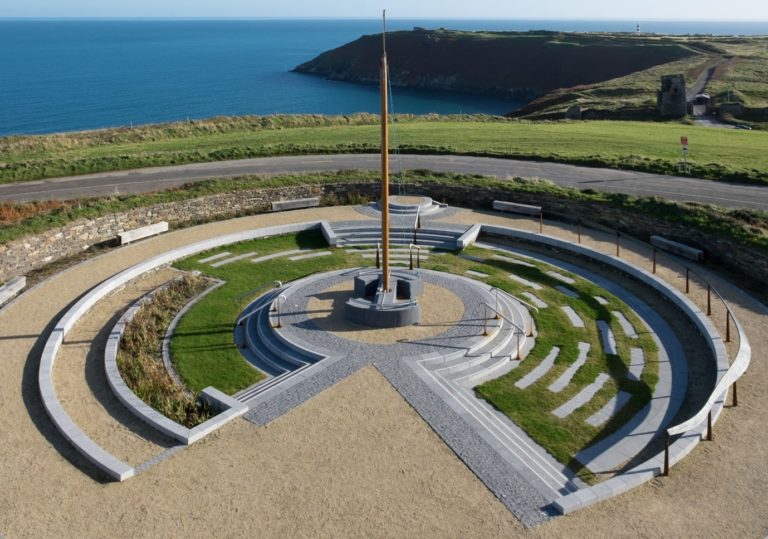
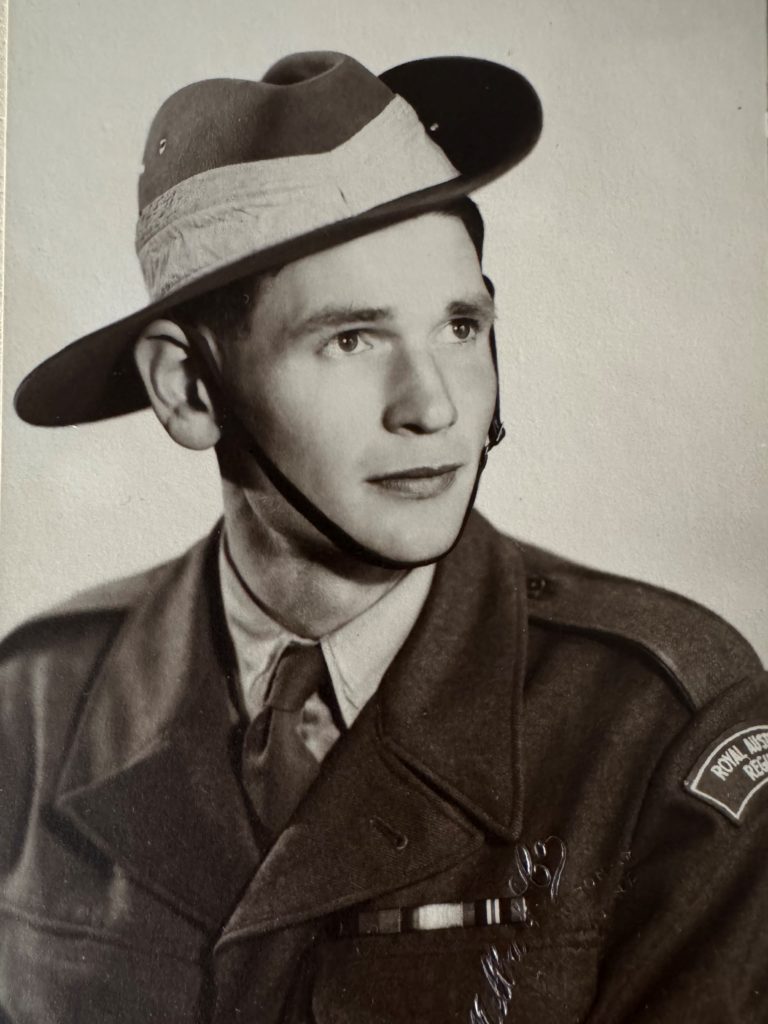

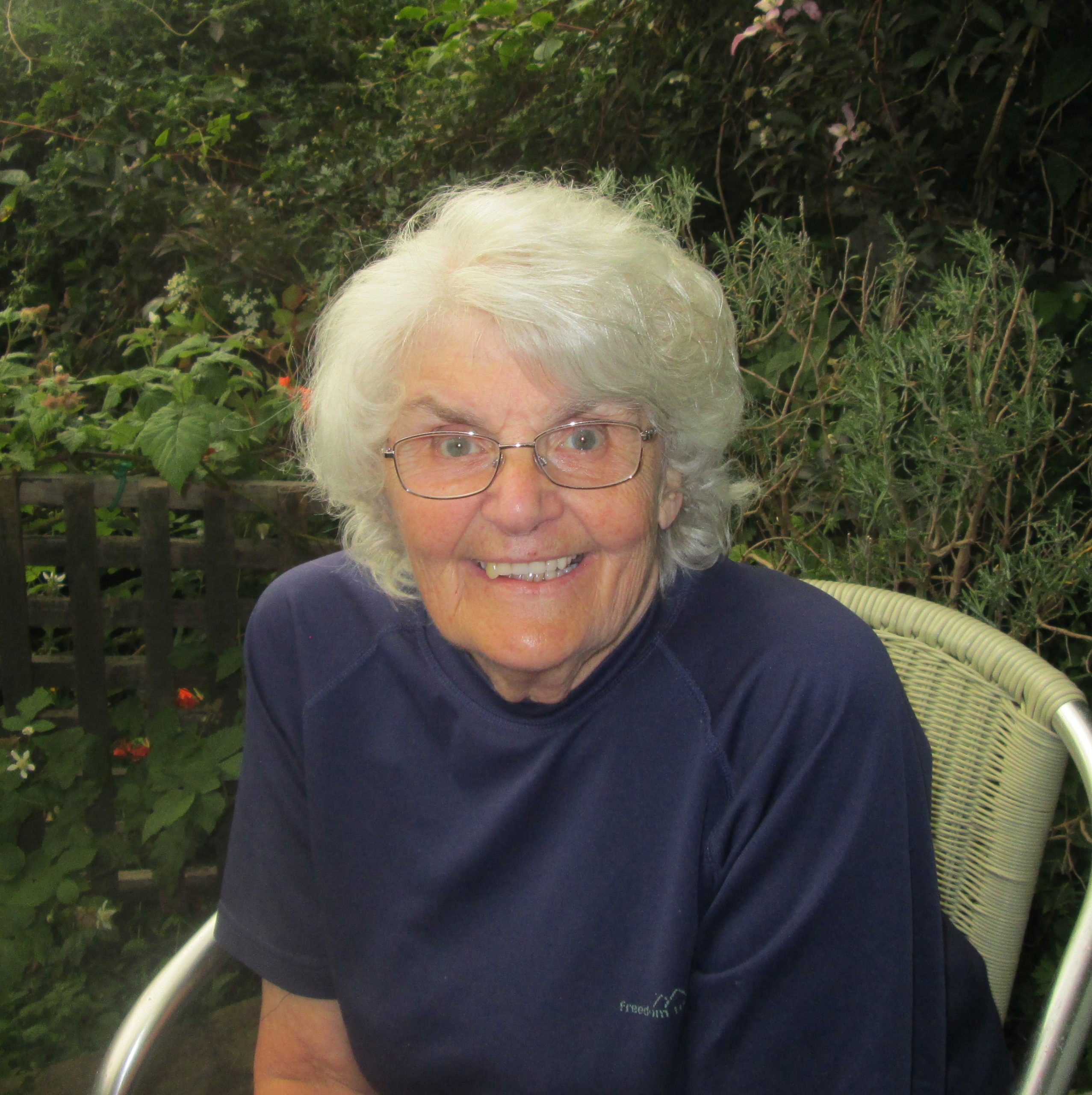



Leave a Comment